warning light FIAT FREEMONT 2011 Owner handbook (in English)
[x] Cancel search | Manufacturer: FIAT, Model Year: 2011, Model line: FREEMONT, Model: FIAT FREEMONT 2011Pages: 267, PDF Size: 5.16 MB
Page 148 of 267
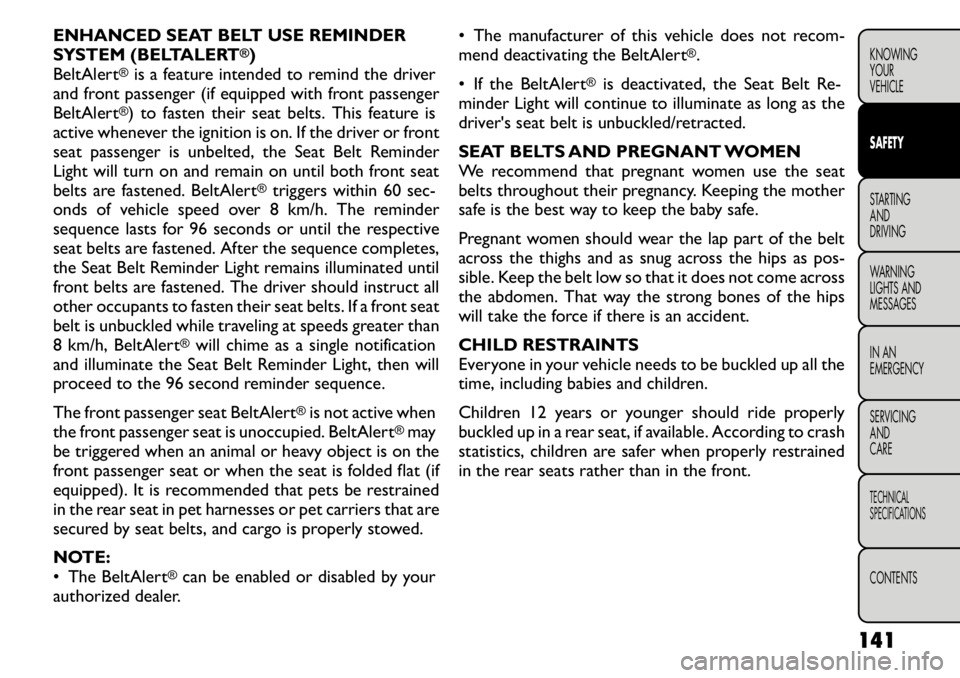
ENHANCED SEAT BELT USE REMINDER
SYSTEM (BELTALERT
®)
BeltAlert
®is a feature intended to remind the driver
and front passenger (if equipped with front passenger
BeltAlert®) to fasten their seat belts. This feature is
active whenever the ignition is on. If the driver or front
seat passenger is unbelted, the Seat Belt Reminder
Light will turn on and remain on until both front seat
belts are fastened. BeltAlert
®triggers within 60 sec-
onds of vehicle speed over 8 km/h. The reminder
sequence lasts for 96 seconds or until the respective
seat belts are fastened. After the sequence completes,
the Seat Belt Reminder Light remains illuminated until
front belts are fastened. The driver should instruct all
other occupants to fasten their seat belts. If a front seat
belt is unbuckled while traveling at speeds greater than
8 km/h, BeltAlert
®will chime as a single notification
and illuminate the Seat Belt Reminder Light, then will
proceed to the 96 second reminder sequence.
The front passenger seat BeltAlert
®is not active when
the front passenger seat is unoccupied. BeltAlert
®may
be triggered when an animal or heavy object is on the
front passenger seat or when the seat is folded flat (if
equipped). It is recommended that pets be restrained
in the rear seat in pet harnesses or pet carriers that are
secured by seat belts, and cargo is properly stowed.
NOTE:
• The BeltAlert
®can be enabled or disabled by your
authorized dealer. • The manufacturer of this vehicle does not recom-
mend deactivating the BeltAlert
®.
• If the BeltAlert
®
is deactivated, the Seat Belt Re-
minder Light will continue to illuminate as long as the
driver's seat belt is unbuckled/retracted.
SEAT BELTS AND PREGNANT WOMEN
We recommend that pregnant women use the seat
belts throughout their pregnancy. Keeping the mother
safe is the best way to keep the baby safe.
Pregnant women should wear the lap part of the belt
across the thighs and as snug across the hips as pos-
sible. Keep the belt low so that it does not come across
the abdomen. That way the strong bones of the hips
will take the force if there is an accident.
CHILD RESTRAINTS
Everyone in your vehicle needs to be buckled up all the
time, including babies and children.
Children 12 years or younger should ride properly
buckled up in a rear seat, if available. According to crash
statistics, children are safer when properly restrained
in the rear seats rather than in the front.
141
KNOWING
YOURVEHICLESAFETYSTARTING ANDDRIVING
WARNING
LIGHTS AND
MESSAGES
IN AN
EMERGENCY
SERVICING AND
CARETECHNICAL
SPECIFICATIONSCONTENTS
Page 149 of 267
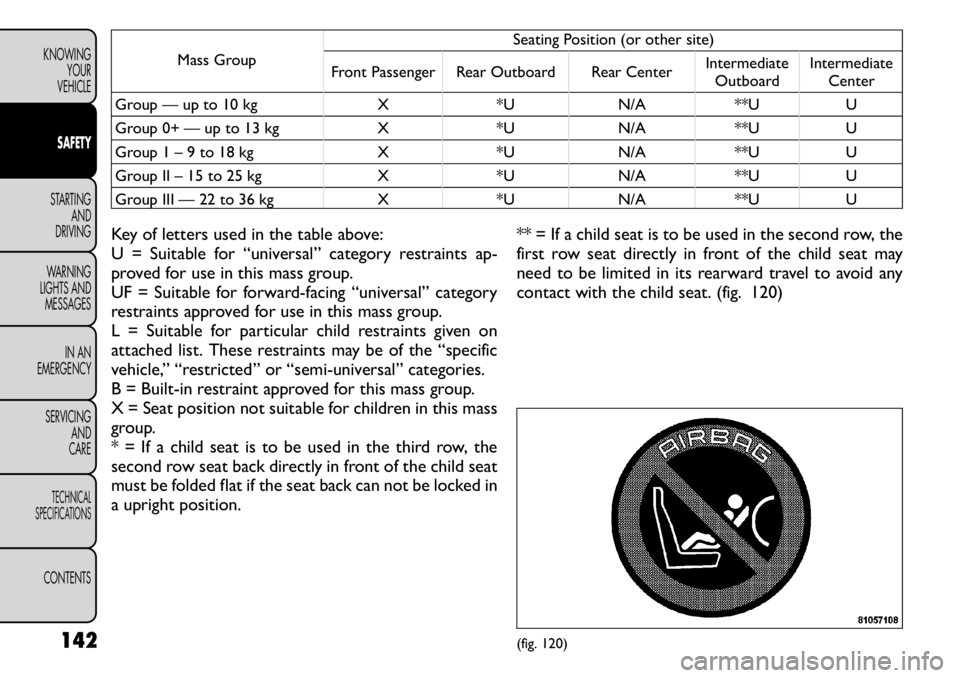
Mass GroupSeating Position (or other site)
Front Passenger Rear Outboard Rear Center Intermediate
Outboard Intermediate
Center
Group — up to 10 kg X *U N/A **U U
Group 0+ — up to 13 kg X *U N/A **U U
Group 1 – 9 to 18 kg X *U N/A **U U
Group II – 15 to 25 kg X *U N/A **U U
Group III — 22 to 36 kg X *U N/A **U U
Key of letters used in the table above:
U = Suitable for “universal” category restraints ap-
proved for use in this mass group.
UF = Suitable for forward-facing “universal” category
restraints approved for use in this mass group.
L = Suitable for particular child restraints given on
attached list. These restraints may be of the “specific
vehicle,” “restricted” or “semi-universal” categories.
B = Built-in restraint approved for this mass group.
X = Seat position not suitable for children in this mass
group.
* = If a child seat is to be used in the third row, the
second row seat back directly in front of the child seat
must be folded flat if the seat back can not be locked in
a upright position. ** = If a child seat is to be used in the second row, the
first row seat directly in front of the child seat may
need to be limited in its rearward travel to avoid any
contact with the child seat. (fig. 120)
(fig. 120)
142
KNOWING
YOUR
VEHICLESAFETYSTARTING AND
DRIVING
WARNING
LIGHTS AND
MESSAGES
IN AN
EMERGENCY
SERVICING AND
CARETECHNICAL
SPECIFICATIONSCONTENTS
Page 150 of 267

WARNING!
“Extreme Hazard! Do not use a
rearward-facing child restraint on a seat
protected by an air bag in front of it!” Refer to
visor and door shut face mounted labels for infor-
mation.
In a collision, an unrestrained child, even a tiny
baby, can become a projectile inside the vehicle.
The force required to hold even an infant on your
lap could become so great that you could not
hold the child, no matter how strong you are.The
child and others could be badly injured. Any child
riding in your vehicle should be in a proper re-
straint for the child's size.
There are different sizes and types of restraints for
children from newborn size to the child almost large
enough for an adult safety belt. Always check the child
seat Owner's Manual to ensure you have the correct
seat for your child. Use the restraint that is correct for
your child.
Infants And Child Restraints
Safety experts recommend that children ride
rearward-facing in the vehicle until they are two years
old or until they reach either the height or weight limit
of their rear facing child safety seat. Two types of child
restraints can be used rearward-facing: infant carriers
and convertible child seats. The infant carrier is only used rearward-facing in the
vehicle. It is recommended for children from birth until
they reach the weight or height limit of the infant
carrier. Convertible child seats can be used either
rearward-facing or forward-facing in the vehicle. Con-
vertible child seats often have a higher weight limit in
the rearward-facing direction than infant carriers do, so
they can be used rearward-facing by children who have
outgrown their infant carrier but are still less than at
least two years old. Children should remain rearward-
facing until they reach the highest weight or height
allowed by their convertible child seat. Both types of
child restraints are held in the vehicle by the lap/
shoulder belt or the ISOFIX child restraint anchor
system. Refer to “ISOFIX — Child Seat Anchorage
System”.
WARNING!
Rearward-facing child seats must never
be used in the front seat of a vehicle with
the front passenger air bag unless the air bag is
turned off. An air bag deployment could cause
severe injury or death to infants in this position.
Older Children And Child Restraints
Children who are two years old or who have outgrown
their rear-facing convertible child seat can ride
forward-facing in the vehicle. Forward-facing child
seats and convertible child seats used in the forward-
facing direction are for children who are over two years
old or who have outgrown the rear-facing weight or 143
KNOWING
YOURVEHICLESAFETYSTARTING ANDDRIVING
WARNING
LIGHTS AND
MESSAGES
IN AN
EMERGENCY
SERVICING AND
CARETECHNICAL
SPECIFICATIONSCONTENTS
Page 151 of 267
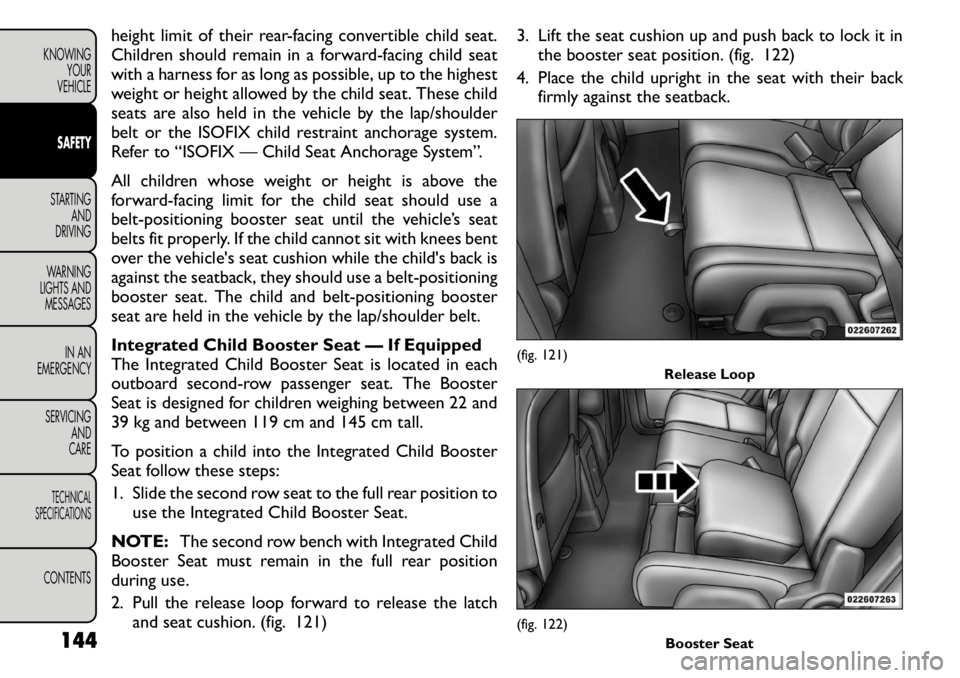
height limit of their rear-facing convertible child seat.
Children should remain in a forward-facing child seat
with a harness for as long as possible, up to the highest
weight or height allowed by the child seat. These child
seats are also held in the vehicle by the lap/shoulder
belt or the ISOFIX child restraint anchorage system.
Refer to “ISOFIX — Child Seat Anchorage System”.
All children whose weight or height is above the
forward-facing limit for the child seat should use a
belt-positioning booster seat until the vehicle’s seat
belts fit properly. If the child cannot sit with knees bent
over the vehicle's seat cushion while the child's back is
against the seatback, they should use a belt-positioning
booster seat. The child and belt-positioning booster
seat are held in the vehicle by the lap/shoulder belt.
Integrated Child Booster Seat — If Equipped
The Integrated Child Booster Seat is located in each
outboard second-row passenger seat. The Booster
Seat is designed for children weighing between 22 and
39 kg and between 119 cm and 145 cm tall.
To position a child into the Integrated Child Booster
Seat follow these steps:
1. Slide the second row seat to the full rear position touse the Integrated Child Booster Seat.
NOTE: The second row bench with Integrated Child
Booster Seat must remain in the full rear position
during use.
2. Pull the release loop forward to release the latch and seat cushion. (fig. 121) 3. Lift the seat cushion up and push back to lock it in
the booster seat position. (fig. 122)
4. Place the child upright in the seat with their back firmly against the seatback.
(fig. 121)
Release Loop(fig. 122) Booster Seat
144
KNOWING
YOUR
VEHICLESAFETYSTARTING AND
DRIVING
WARNING
LIGHTS AND
MESSAGES
IN AN
EMERGENCY
SERVICING AND
CARETECHNICAL
SPECIFICATIONSCONTENTS
Page 152 of 267
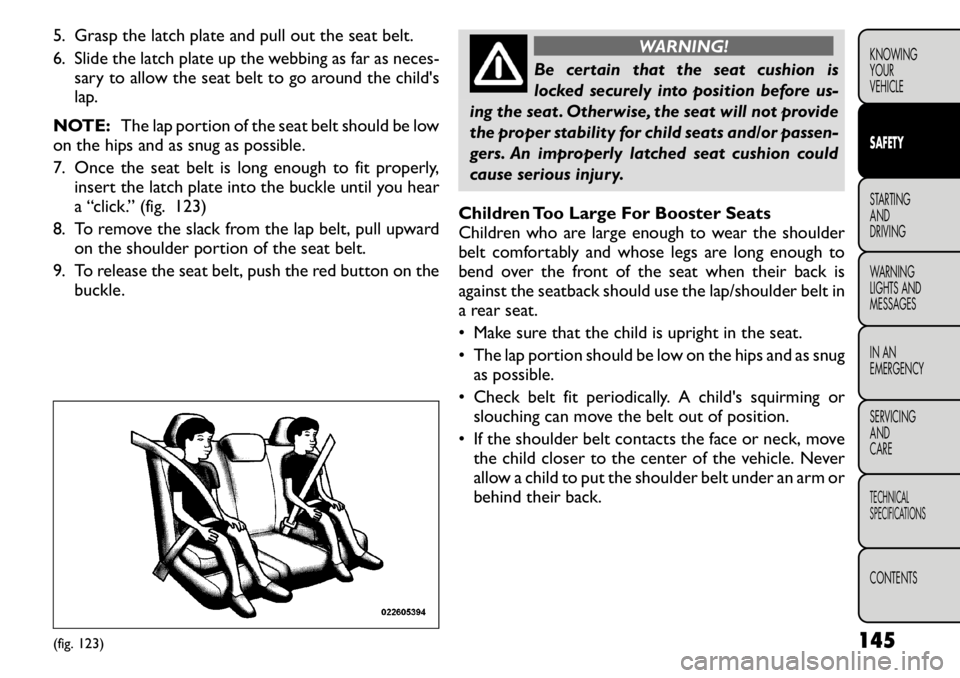
5. Grasp the latch plate and pull out the seat belt.
6. Slide the latch plate up the webbing as far as neces-sary to allow the seat belt to go around the child's
lap.
NOTE: The lap portion of the seat belt should be low
on the hips and as snug as possible.
7. Once the seat belt is long enough to fit properly, insert the latch plate into the buckle until you hear
a “click.” (fig. 123)
8. To remove the slack from the lap belt, pull upward on the shoulder portion of the seat belt.
9. To release the seat belt, push the red button on the buckle.
WARNING!
Be certain that the seat cushion is
locked securely into position before us-
ing the seat . Otherwise, the seat will not provide
the proper stability for child seats and/or passen-
gers. An improperly latched seat cushion could
cause serious injury.
Children Too Large For Booster Seats
Children who are large enough to wear the shoulder
belt comfortably and whose legs are long enough to
bend over the front of the seat when their back is
against the seatback should use the lap/shoulder belt in
a rear seat.
• Make sure that the child is upright in the seat.
• The lap portion should be low on the hips and as snug as possible.
• Check belt fit periodically. A child's squirming or slouching can move the belt out of position.
• If the shoulder belt contacts the face or neck, move the child closer to the center of the vehicle. Never
allow a child to put the shoulder belt under an arm or
behind their back.
(fig. 123) 145
KNOWING
YOURVEHICLESAFETYSTARTING ANDDRIVING
WARNING
LIGHTS AND
MESSAGES
IN AN
EMERGENCY
SERVICING AND
CARETECHNICAL
SPECIFICATIONSCONTENTS
Page 153 of 267
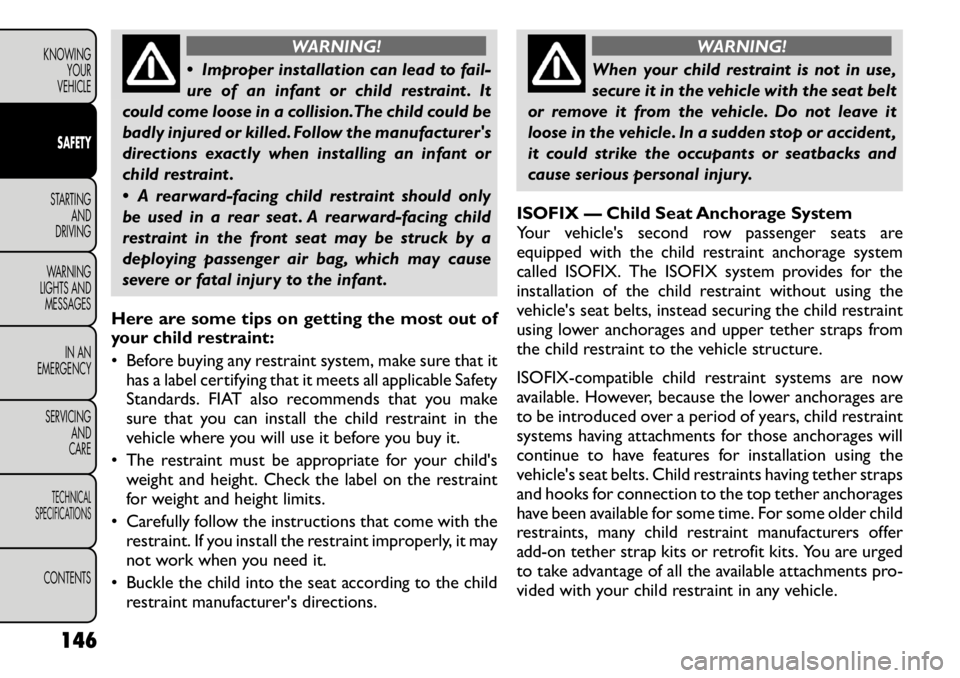
WARNING!
Improper installation can lead to fail-
ure of an infant or child restraint . It
could come loose in a collision.The child could be
badly injured or killed. Follow the manufacturer's
directions exactly when installing an infant or
child restraint .
A rearward-facing child restraint should only
be used in a rear seat . A rearward-facing child
restraint in the front seat may be struck by a
deploying passenger air bag, which may cause
severe or fatal injury to the infant .
Here are some tips on getting the most out of
your child restraint:
• Before buying any restraint system, make sure that it has a label certifying that it meets all applicable Safety
Standards. FIAT also recommends that you make
sure that you can install the child restraint in the
vehicle where you will use it before you buy it.
• The restraint must be appropriate for your child's weight and height. Check the label on the restraint
for weight and height limits.
• Carefully follow the instructions that come with the restraint. If you install the restraint improperly, it may
not work when you need it.
• Buckle the child into the seat according to the child restraint manufacturer's directions.
WARNING!
When your child restraint is not in use,
secure it in the vehicle with the seat belt
or remove it from the vehicle. Do not leave it
loose in the vehicle. In a sudden stop or accident ,
it could strike the occupants or seatbacks and
cause serious personal injury.
ISOFIX — Child Seat Anchorage System
Your vehicle's second row passenger seats are
equipped with the child restraint anchorage system
called ISOFIX. The ISOFIX system provides for the
installation of the child restraint without using the
vehicle's seat belts, instead securing the child restraint
using lower anchorages and upper tether straps from
the child restraint to the vehicle structure.
ISOFIX-compatible child restraint systems are now
available. However, because the lower anchorages are
to be introduced over a period of years, child restraint
systems having attachments for those anchorages will
continue to have features for installation using the
vehicle's seat belts. Child restraints having tether straps
and hooks for connection to the top tether anchorages
have been available for some time. For some older child
restraints, many child restraint manufacturers offer
add-on tether strap kits or retrofit kits. You are urged
to take advantage of all the available attachments pro-
vided with your child restraint in any vehicle.
146
KNOWING YOUR
VEHICLESAFETYSTARTING AND
DRIVING
WARNING
LIGHTS AND
MESSAGES
IN AN
EMERGENCY
SERVICING AND
CARETECHNICAL
SPECIFICATIONSCONTENTS
Page 154 of 267
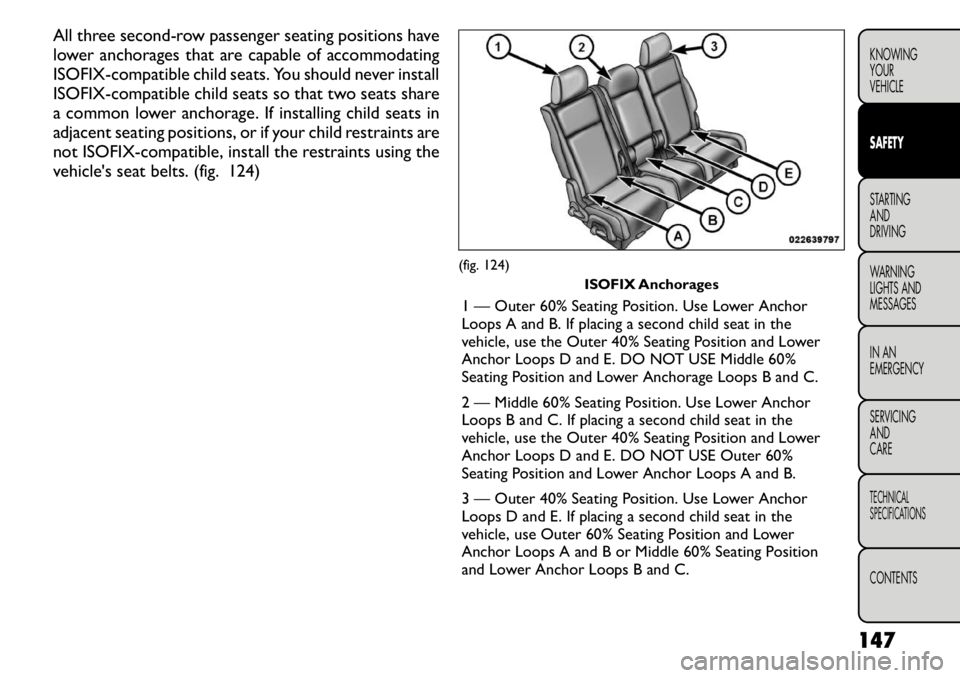
All three second-row passenger seating positions have
lower anchorages that are capable of accommodating
ISOFIX-compatible child seats. You should never install
ISOFIX-compatible child seats so that two seats share
a common lower anchorage. If installing child seats in
adjacent seating positions, or if your child restraints are
not ISOFIX-compatible, install the restraints using the
vehicle's seat belts. (fig. 124)
(fig. 124)ISOFIX Anchorages
1 — Outer 60% Seating Position. Use Lower Anchor
Loops A and B. If placing a second child seat in the
vehicle, use the Outer 40% Seating Position and Lower
Anchor Loops D and E. DO NOT USE Middle 60%
Seating Position and Lower Anchorage Loops B and C.
2 — Middle 60% Seating Position. Use Lower Anchor
Loops B and C. If placing a second child seat in the
vehicle, use the Outer 40% Seating Position and Lower
Anchor Loops D and E. DO NOT USE Outer 60%
Seating Position and Lower Anchor Loops A and B.
3 — Outer 40% Seating Position. Use Lower Anchor
Loops D and E. If placing a second child seat in the
vehicle, use Outer 60% Seating Position and Lower
Anchor Loops A and B or Middle 60% Seating Position
and Lower Anchor Loops B and C.
147
KNOWING
YOURVEHICLESAFETYSTARTING ANDDRIVING
WARNING
LIGHTS AND
MESSAGES
IN AN
EMERGENCY
SERVICING AND
CARETECHNICAL
SPECIFICATIONSCONTENTS
Page 155 of 267

Vehicle ISOFIX Positions Chart
Mass Group Size
Class Fixture Front
Passenger Rear
Outboard Rear
Center Intermediate
Outboard
Right / Left Intermediate
Center Other Sites
Carrycot F ISO/L1 X X X **IUF / X **IUF X
G ISO/L2 X X X X / **IUF X X (1) X X X X X X
0 — up to 10 kg E ISO/R1 X X X *IUF / *IUF *IUF X
(1) X X X X X X
0+ — up to 13 kg E ISO/R1 X X X *IUF / *IUF *IUF X
D ISO/R2 X X X *IUF / *IUF *IUF X C ISO/R3 X X X *IUF / *IUF *IUF X (1) X X X X X X
I – 9 to 18 kg D ISO/R2 X X X *IUF / *IUF *IUF X
C ISO/R3 X X X *IUF / *IUF *IUF X B ISO/F2 X X X IUF / IUF IUF X
B1 ISO/F2X X X X IUF / IUF IUF X
A ISO/F3 X X X IUF / IUF IUF X (1) X X X X X X
II – 15 to 25 kg (1) X X X X X X III – 22 to36 kg (1) X X X X X X
Key of letters used in the table above:
(1) = For the CRS which do not carry the ISO/XX size
class identification (A to G), for the applicable mass
group, the car manufacturer shall indicate the vehicle specific ISOFIX child restraint system(s) recommended
for each position.
IUF = Suitable for ISOFIX forward child restraints
systems of universal category approved for use in the
mass group.
148
KNOWING
YOUR
VEHICLESAFETYSTARTING AND
DRIVING
WARNING
LIGHTS AND
MESSAGES
IN AN
EMERGENCY
SERVICING AND
CARETECHNICAL
SPECIFICATIONSCONTENTS
Page 156 of 267
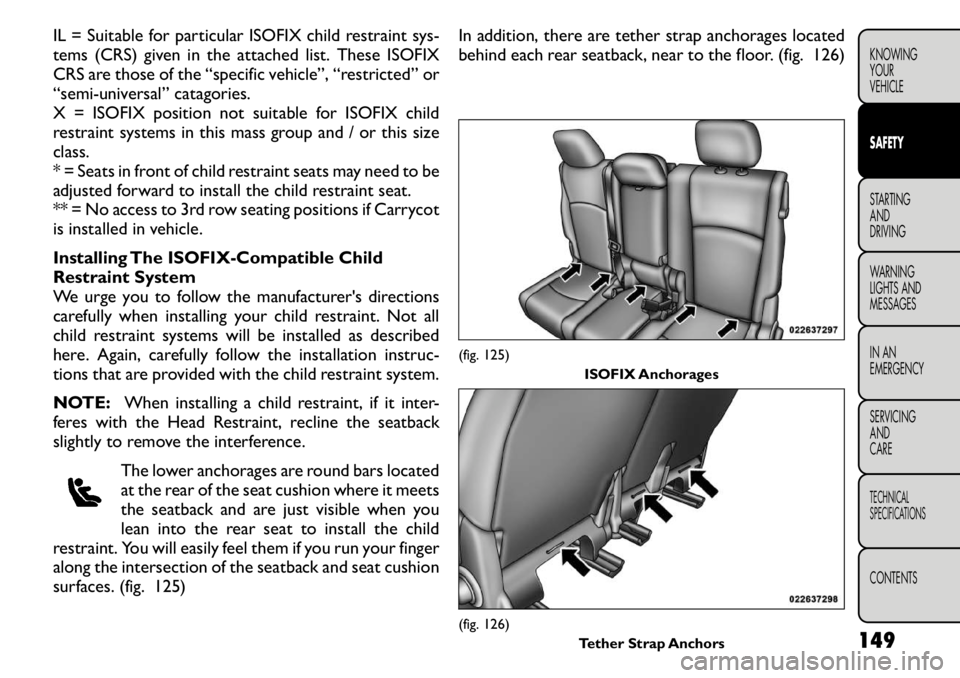
IL = Suitable for particular ISOFIX child restraint sys-
tems (CRS) given in the attached list. These ISOFIX
CRS are those of the “specific vehicle”, “restricted” or
“semi-universal” catagories.
X = ISOFIX position not suitable for ISOFIX child
restraint systems in this mass group and / or this sizeclass.
* = Seats in front of child restraint seats may need to be
adjusted forward to install the child restraint seat.
** = No access to 3rd row seating positions if Carrycot
is installed in vehicle.
Installing The ISOFIX-Compatible Child
Restraint System
We urge you to follow the manufacturer's directions
carefully when installing your child restraint. Not all
child restraint systems will be installed as described
here. Again, carefully follow the installation instruc-
tions that are provided with the child restraint system.
NOTE:When installing a child restraint, if it inter-
feres with the Head Restraint, recline the seatback
slightly to remove the interference.
The lower anchorages are round bars located
at the rear of the seat cushion where it meets
the seatback and are just visible when you
lean into the rear seat to install the child
restraint. You will easily feel them if you run your finger
along the intersection of the seatback and seat cushion
surfaces. (fig. 125) In addition, there are tether strap anchorages located
behind each rear seatback, near to the floor. (fig. 126)
(fig. 125)
ISOFIX Anchorages(fig. 126)Tether Strap Anchors 149
KNOWING
YOURVEHICLESAFETYSTARTING ANDDRIVING
WARNING
LIGHTS AND
MESSAGES
IN AN
EMERGENCY
SERVICING AND
CARETECHNICAL
SPECIFICATIONSCONTENTS
Page 157 of 267

Many, but not all, restraint systems will be equipped
with separate straps on each side, with each having a
hook or connector for attachment to the lower an-
chorage and a means of adjusting the tension in the
strap. Forward-facing toddler restraints and some rear-
facing infant restraints will also be equipped with a
tether strap, a hook for attachment to the tether strap
anchorage and a means of adjusting the tension of the
strap.
You will first loosen the child seat adjusters on the
lower straps and on the tether strap so that you can
more easily attach the hooks or connectors to the
vehicle anchorages. Next, attach the lower hooks or
connectors over the top of the seatcover material.
Then attach the tether strap to the anchorage directly
behind the seat where you are placing the child re-
straint, being careful to route the tether strap to
provide the most direct path between the anchor and
the child restraint, preferably between the head re-
straint posts underneath the head restraint. For center
seating position, adjust the head restraint to the up-
ward position and route the tether strap between the
head restraint posts underneath the head restraint.
Then, attach the hook to the tether anchor located on
the back of the seat. Finally, tighten all three straps as
you push the child restraint rearward and downward
into the seat, removing slack in the straps according to
the child restraint manufacturer's instructions.NOTE:
• Ensure that the tether strap does not slip into the
opening between the seatbacks as you remove slack in
the strap.
• When using the ISOFIX attaching system to install a
child restraint, please ensure that all seat belts not
being used for occupant restraints are stowed and out
of reach of children. Remind all children in the vehicle
that the seat belts are not toys and that they should not
play with them. In addition, never leave unattended
children in the vehicle.
WARNING!
Improper installation of a child restraint
to the ISOFIX anchorages can lead to
failure of an infant or child restraint . The child
could be badly injured or killed. Follow the manu-
facturer's directions exactly when installing an
infant or child restraint .
150
KNOWING YOUR
VEHICLESAFETYSTARTING AND
DRIVING
WARNING
LIGHTS AND
MESSAGES
IN AN
EMERGENCY
SERVICING AND
CARETECHNICAL
SPECIFICATIONSCONTENTS